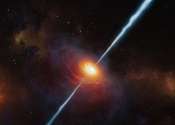ALMA: New receivers achieve first light, set record for observational capabilities
A new set of receivers installed on antennas at the Atacama Large Millimeter/submillimeter Array (ALMA) have achieved first light. With it, they set a new record for the longest wavelengths visible with the radio array. The ...









